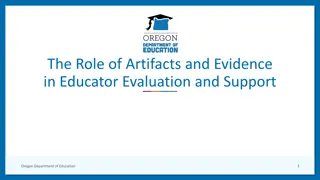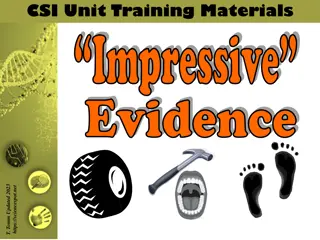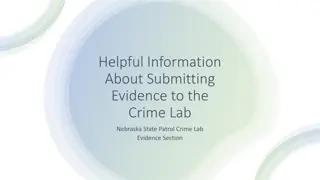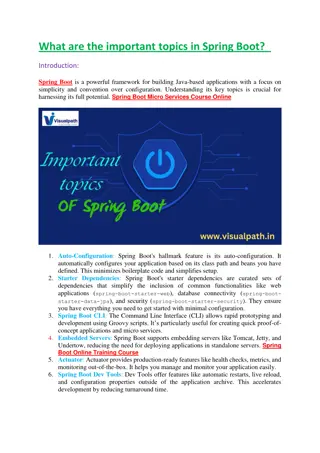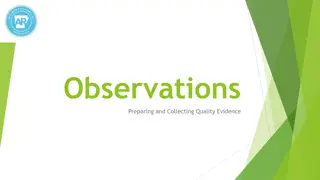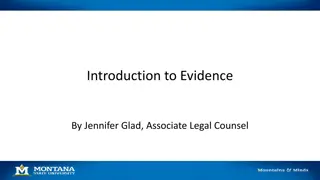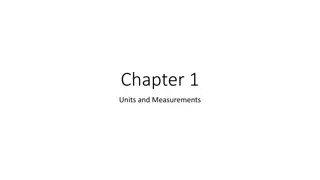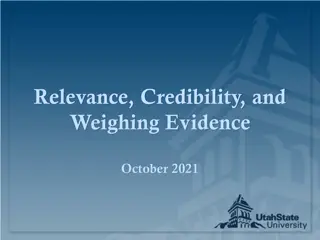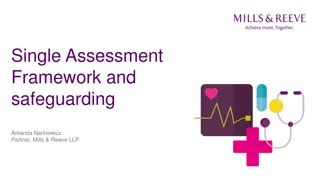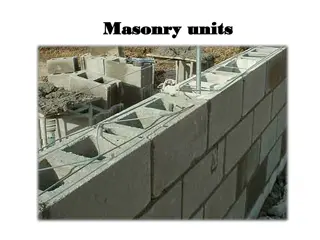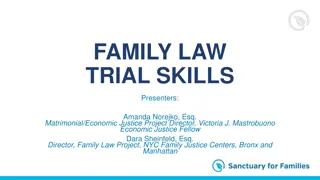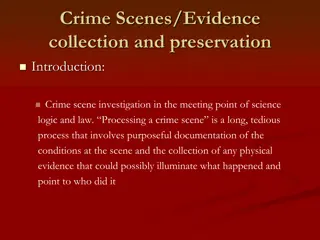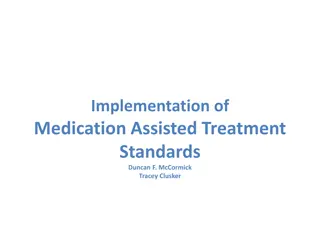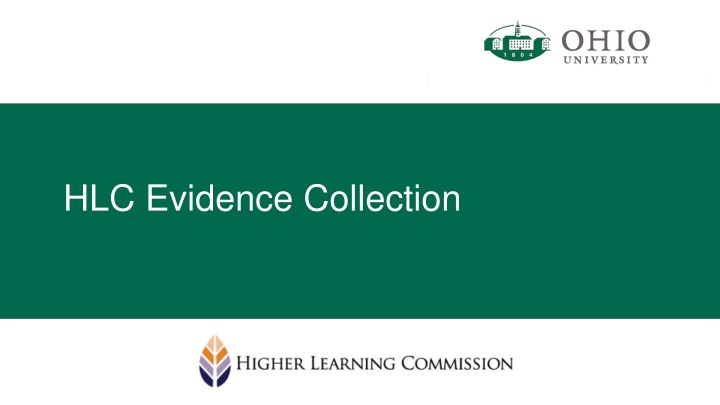
Institutional Accreditation and Evidence Collection Process Overview
Learn about the importance of institutional accreditation and evidence collection in ensuring educational quality and accountability. Explore the criteria for accreditation, evidence-based arguments, and the evidence collection cycle for institutions. Understand how institutions provide evidence to demonstrate compliance, academic quality, and financial sustainability.
Download Presentation

Please find below an Image/Link to download the presentation.
The content on the website is provided AS IS for your information and personal use only. It may not be sold, licensed, or shared on other websites without obtaining consent from the author. If you encounter any issues during the download, it is possible that the publisher has removed the file from their server.
You are allowed to download the files provided on this website for personal or commercial use, subject to the condition that they are used lawfully. All files are the property of their respective owners.
The content on the website is provided AS IS for your information and personal use only. It may not be sold, licensed, or shared on other websites without obtaining consent from the author.
E N D
Presentation Transcript
Institutional Accreditation Accreditation is not a separate burden imposed on Universities; accreditation is the process by which we are held accountable for our institutional effectiveness.
Criteria for Accreditation Five Criteria (18 Core Components) 1. Mission The institution s mission is clear and articulated publicly; it guides the institution s operations. 2. Integrity: Ethical and Responsible Conduct The institution acts with integrity; its conduct is ethical and responsible. 3. Teaching and Learning: Quality, Resources, and Support The institution provides quality education, wherever and however its offerings are delivered. 4. Teaching and Learning: Evaluation and Improvement The institution demonstrates responsibility for the quality of its educational programs, learning environments, and support services, and it evaluates their effectiveness for student learning through processes designed to promote continuous improvement. 5. Institutional Effectiveness, Resources and Planning The institution s resources, structures, and processes are sufficient to fulfill its mission, improve the quality of its educational offerings, and respond to future challenges and opportunities. Criteria for Accreditation (CRRT.B.10.010) | Policies (hlcommission.org)
More Evidence-based Argument Kansas State U Assurance Argument example Criterion 4 Core Component 4B Learning Assessment Minimal text Extensive sources
HLC Evidence Collection HLC encourages institutions to provide thorough evidence and ensure that the sources it selects are relevant and persuasive. Evidence should: 1. Explain any nuances specific to the institution; 2. Strengthenthe institution s overall record of compliance with HLC s requirement; and 3. Affirm the institution s overall academic quality and financial sustainability and integrity.
The Evidence Collection Cycle Evidence Committees (ECs) Identify Possible Evidence ECs Provide Recommendations for the Coming Year Evidence Request Lists Combined ECs Review Evidence & Perform Gap Analysis IEA Sends Requests for Evidence Units Respond with Evidence or Suggestions
Evidence Request Table Is there alternative or additional documenta tion that could be used as evidence? Y/N HLC Criterion /Core Compon ent Code HLC Criterion/Core Component The institution s educational responsibilities take primacy over other purposes, such as generating financial returns for investors, contributing to a related or parent organization, or supporting external interests. The institution s educational responsibilities take primacy over other purposes, such as generating financial returns for investors, contributing to a related or parent organization, or supporting external interests. Eviden ce Uploa ded (Y/N) If No, please provide reason If yes, upload to folder and indicate name of document below. Program or Office Name Evidence identified Upload Folder Link University Budget Books for FY 20, 21, 22, 23; Budget planning guidance sent to VPs in Fall 2022 Meeting minute and agendas from the Capital Planning and Facilities committee when this was discussed.(Relevant sections highlighted) Vice President for Finance & Administration Univerity and unit budget documents - VPFA archives 1.B.2 Y Subcomponent 1B2 Vice President for Finance & Administration Records from Capital Planning and Facilities Committee 1.B.2 Y Subcomponent 1B2 Receipts or other documentation from procurement or Bobcat Buy would not answer the question about how we engage our external constituencies. and the University responds with actions. Better evidence might be mtg agendas, conference schedules, mtg schedules, minutes where needs are discussed. Reach out to Event services or units hosting these events/mtgs. Subcomponent 1B3 The institution engages with its external constituencies and responds to their needs as its mission and capacity allow. Vice President for Finance & Administration Vendor and consultant receipts from procurement/Bobcat Buy 1.B.3 N Y
Using Core Components to Help Understand If you aren't sure what the subcomponent is talking about, you can move one or two levels up for a broader view. Use this link: HLC Criteria and Core Components to find more info Criterion 3 The institution provides quality education, wherever and however its offerings are delivered. Core Component 3.A. The rigor of the institution s academic offerings is appropriate to higher education. Sub-Component 3.A.1 Courses and programs are current and require levels of student performance appropriate to the credential awarded. This Photo by Unknown author is licensed under CC BY-SA-NC.
Evaluating the Evidence 1. Quality over Quantity BUT, documentation across the institution breadth of evidence 2. Focus on 2019 forward a) a) Unless the evidence precedes 2019 For Example, the approval of the Mission 3. Look at the HLC Evidence guidelines 4. Prioritize Clear Evidence i.
HLC Evidence Guidelines HLC encourages institutions to provide thorough evidence and ensure that the sources it selects are relevant and persuasive. Evidence should: 1. Explain any nuances specific to the institution; 2. Strengthenthe institution s overall record of compliance with HLC s requirement; and 3. Affirm the institution s overall academic quality and financial sustainability and integrity.
A Focus on Clear Evidence Three types of evidence: 1. Clear evidence 2. Corroborating evidence 3. Circumstantial evidence
A Focus on Clear Evidence Types of Evidence: 1. Clear evidence precise, explicit and tends to directly establish the point it is presented to support. Institutions should provide clear evidence of their compliance with each Core Component. Example: Clear evidence that a president was duly appointed by an institution s board would be a board resolution or meeting minutes showing a motion and vote to hire the president.
What is Compelling Evidence? Types of Evidence: 2. Corroborating evidence supplementary to evidence already given and tends to strengthen or confirm it. This type of evidence can be useful in illustrating points made in the institution s narrative, but it may not be persuasive to peer reviewers on its own. Example: Corroborating evidence that a president was duly appointed by an institution s board would be a copy of the offer letter addressed to the president.
What is Compelling Evidence? Types of Evidence: 3. Circumstantial evidence establishes a condition of surrounding circumstances, from which the principal fact may be inferred. This type of evidence is never sufficient on its own. Example: Circumstantial evidence that a president was duly appointed by an institution s board would be a copy of a letter from the president to the chair of the board, accepting the presidential appointment.
What is Compelling Evidence? Three types of evidence: 1. Clear evidence 2. Corroborating evidence 3. Circumstantial evidence
The Evidence Collection Cycle Evidence Committees (ECs) Identify Possible Evidence ECs Provide Recommendations for the Coming Year Evidence Request Lists Combined ECs Review Evidence & Perform Gap Analysis IEA Sends Requests for Evidence Units Respond with Evidence or Suggestions


